Dress with black inserts on the sides. Dresses with inserts.
Fix your gaze on this popular dress with shaped longitudinal seams at the front and back and feel incomparable. Made from lightweight stretch fabric. Front V-shaped top neckline, V- inserts and a hidden zipper to the waist. Wide skirt. Wide shoulders with short sleeves. Additional zipper. 87% wool, 9% polyester, 4% elastane. Belt: 50% polyurethane, 50% brass. Blue color.
Read more...
Pay attention to this stylish dress made of thick elastic fabric and feel charming. Round cutout neckline with small cutouts front. The neckline is decorated with golden accessories and rhinestones. Short sleeves. Separate belt with gold-tone metal buckle. Zip fastening and a small slit in the middle of the back. Narrow shape. 56% polyamide, 27% viscose, 12% elastane, 5% wool. Belt: 100% polyurethane. Color: smoky blue.
Read more...
This attractive look in a dress
Opt for this trendy waffle knit dress and feel seductive. Decorated with an armored chain on the front cutout. Partially lined with jersey at the neckline. Figure flattering cut. Length: approx. 98 cm. 95% polyester, 5% elastane. Knit lining: 100% polyamide. . Color: white/black.
Read more...
A fashionable dress is a great option for a new style
Take a closer look at this luxury jacquard dress with cutout boat front and feel glamorous. The tone of the dress perfectly matches the summer lightness of the material, which is not see-through thanks to the lining. The seams on the front and back of the sheath dress excite the figure, giving it shape. Zip fastening in the middle at the back. This Short dress made of jacquard with its fresh colorful print always lifts your spirits! 70% polyester, 30% cotton. Lining: 100% polyamide. Color: cream/red.
Read more...
Set your sights on this beautiful dress with slightly flared cuffs long sleeves and feel amazing. Made from quality jersey material. The shape of the dress is fitted, but at the same time loose. Front the part is made with an attractive round groove that has a front cutout and fastens with a fashionable, sophisticated placket. If you need to be comfortable, simple and elegant, then you will look absolutely unbeatable in this 70s style dress! 85% polyester, 10% viscose, 5% elastane. Orange color.
The most famous lace fabric is, of course, guipure. Inserts made from this fabric allow you to turn an ordinary dress into a festive outfit.
History of fabric
The name of the fabric comes from French, the word can be translated as “air openwork”. The fabric is a type of lace with a convex through pattern.
Guipure was first produced in the 16th century and its homeland is Venice. At first, this material was produced in the form of braid, used to decorate outfits; later, the fabric began to be produced in the form of a single piece.

Nowadays, the production of guipure is automated; machines make patterns according to the program entered into them. To make guipure, natural (cotton, silk) or synthetic threads are used. There are several options for guipure on sale:

- Classic. Tender and beautiful fabric, used for sewing and decorating clothes.
- Metallic. Made with the addition of shiny threads, the fabric has a characteristic shine.
- Net. The thinnest type of guipure, the material is almost transparent.
- Elastic. The fabric is made with the addition of elastic threads, so it has excellent stretch; this option is great for making inserts on dresses or blouses.
Application
Guipure is used mainly for sewing elegant clothes. Since this material is translucent, dresses and blouses are sewn on a cover. But dresses with guipure inserts are no less popular. Such outfits are elegant, elegant and seductive. To combine with guipure, different fabrics are used, most often satin, velvet, chiffon, silk.
![]()
Photos from fashion catwalks make it clear that the use of guipure to decorate evening, wedding and even everyday dresses is often used by designers. Any fashionista can afford such dresses, regardless of age and physique. You just need to choose the right style and color of the outfit.
Varieties
Guipure can be used to cut out various details of a dress. This fabric is used for small inserts or individual elements of the outfit are completely cut out of it.
Lace top
Outfits with a bodice made of guipure and skirts made of a different material look gentle and feminine. Of course, to make the outfit look decent, the bodice is made of two layers: the top layer is cut out of openwork guipure, and the bottom layer is made of thick fabric.

Guipure is often used to make individual parts bodice. For example, a classic solution is a dress with a guipure insert in the front. Such an insert is appropriate even in business clothes, provided that the insert is not transparent. In this case, the guipure is simply applied to the front piece, cut from the main fabric.
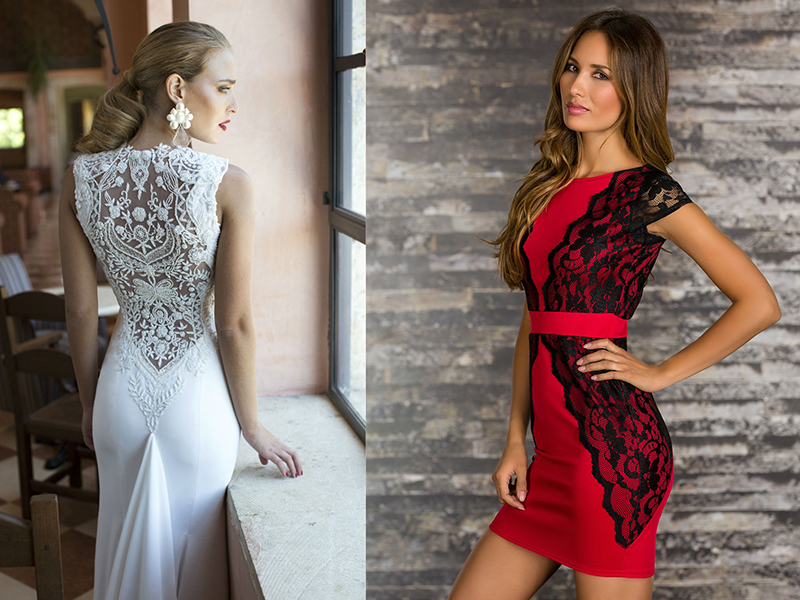
Evening dresses with lace inserts on the back look impressive. In fact, this is a more modest version of outrageous outfits with an open back. Not all fashionistas decide to wear a dress with a deep neckline in the back, since only those who own it can wear such an outfit perfect skin. If your back is covered with freckles or there are visible marks on your skin from the straps of a swimsuit, then it is better to choose a dress in which the neckline is completely covered with translucent guipure. It looks no less impressive, but allows you to hide imperfections.
Another option for placing lace inserts is on the sides. Such inserts can be present in both fitted and one piece dress. If you use guipure for inserts, which is darker than the main fabric of the dress, then a dress with guipure inserts on the sides will help visually adjust the silhouette, giving it a seductive outline. This outfit option is recommended for girls who do not have a defined waist.
Sleeves
Lace sleeves are classic solution, which is often used in evening and wedding fashion. This solution is perfect for fat girls, as well as for overly thin fashionistas, as it allows you to hide not too attractive top part hands

Guipure sleeves are usually sewn narrow, fitting the arm. They don't have to be long; the most popular length is three-quarters or elbow length.

If a girl has too thin arms, then lace sleeves can be made puffy and flared.
Often the lace sleeves extend into the lace top of the dress. This solution is especially recommended for fashionistas with a pear-shaped body type. It will visually expand the shoulder line.
Belt
Belt - interesting detail, allowing you to correctly place accents. The lace belt looks especially impressive. Such a detail must be sewn on a cover, since guipure is too thin a fabric, so it cannot hold its shape. The belt can be matched to the dress, but models are often chosen contrasting color. For example, White dress It will look especially impressive with a lace belt in red, blue, green or black. Against the background of a black dress, a belt made of metallic guipure in silver or gold will look original. The belt can be either sewn in or made as a separate part.

The shape of the lace belt is selected depending on the type of figure. Women of fashion with a figure are most fortunate; they can use any lace belts for dresses - wide, narrow, with decoration.

If the figure resembles a silhouette, then you need to give preference to wide guipure belts, they will emphasize thin waist and will distract attention from wide hips. If the silhouette of the figure is closer to an inverted triangle, then it is recommended to use thin lace belts. But for girls with a rectangular body type, corset belts made of elastic guipure with a slimming lining are ideal.
Basque
Dresses with guipure basques look charming. To sew this part, it is necessary to use a hard version of guipure so that the peplum holds its shape.

Peplum can be a detail of dresses different styles. It can be used to decorate pencil or sheath-cut dresses, or to decorate evening dresses with a mermaid or princess cut.
Skirts
An interesting option is a dress with guipure inserts at the bottom. The insert can be made in the form of a frill along the hem or in the form of triangular wedge inserts used for sewing year-old skirts.

Skirts with inserts in the form of a frill along the hem can be either straight or fluffy. If you are sewing a floor-length dress, then the translucent guipure insert can be very wide, starting from the knee line.
Color spectrum
The classic solution is black dress with guipure inserts. Black color is universal, it suits almost everyone and is suitable for any situation, allowing you to combine severity and playfulness. In addition, any accessories look incredibly impressive against the background of a black dress.
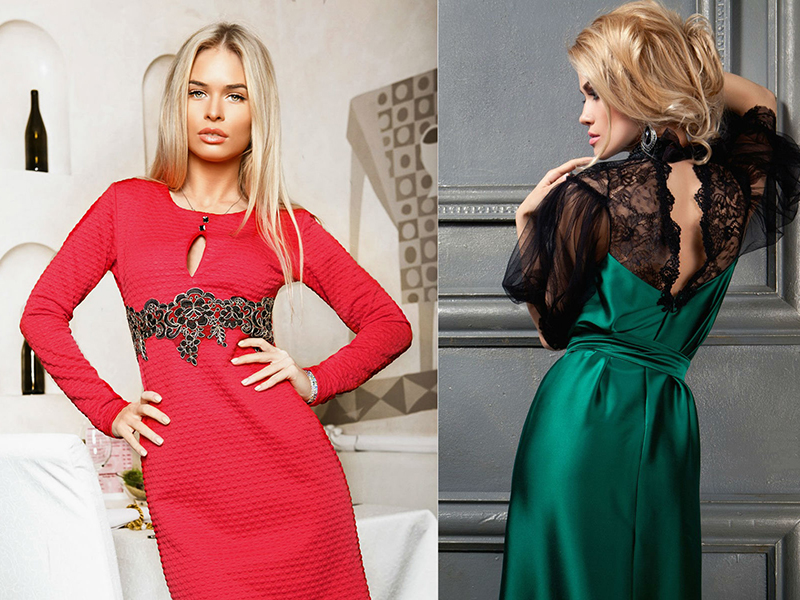
Perfect for a party or attending a theater premiere bright dress with guipure inserts. The outfit can be red, blue, emerald or golden.
Dresses pastel shades, decorated with guipure inserts - this is an excellent choice for a daytime celebration or a walk around the city. Brides traditionally choose dresses with white lace.

Most often, guipure inserts are of the same shade as the main fabric. But sometimes the inserts are made in a contrasting color. Using this technique, you can correctly place accents and visually correct your figure.
What to combine with?
The choice of accessories is determined by the purpose of the ensemble. For creating everyday look on the basis of a dress with guipure inserts is worth choosing classic shoes or sandals and a rectangular clutch.

Guipure goes perfectly with various hats, so if you choose a beautiful hat with your dress, you will get a cute and feminine retro look. It would be nice to wear a vintage brooch with this outfit.
If a fashionista decides to wear a dress with guipure inserts in the cold season, then she will need to choose a trapezoid-shaped coat to go with it. The best option shoes - classic boots or feminine ankle boots. You can create a shocking image by combining a dress with guipure inserts with leather jacket and army style boots.
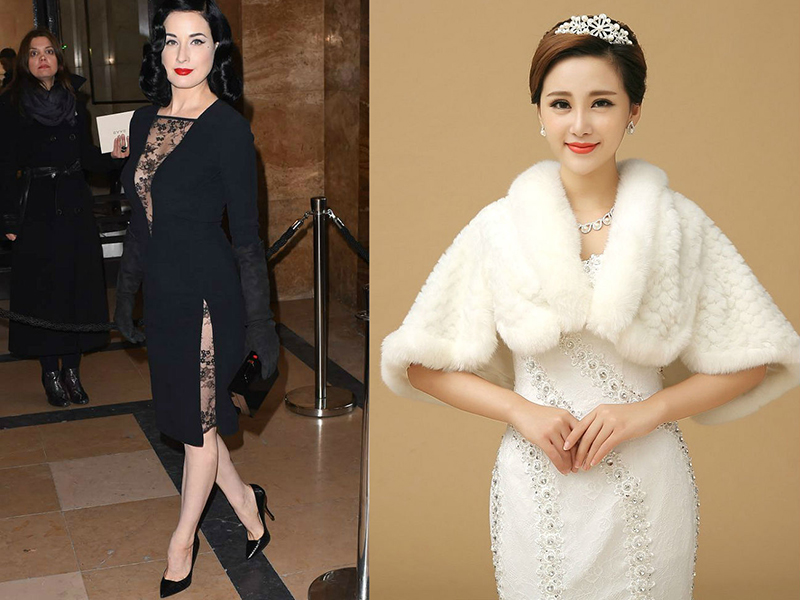
For an evening out, dresses with guipure inserts can be complemented with an airy stole, and in winter - with a fur cape. You need to choose classic shoes - stiletto heels. There shouldn’t be a lot of decorations, but they can be massive.
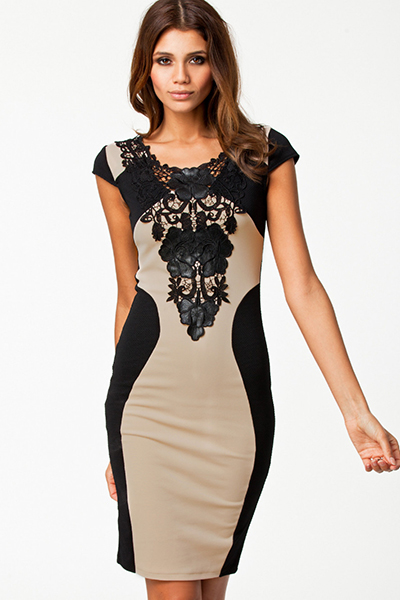

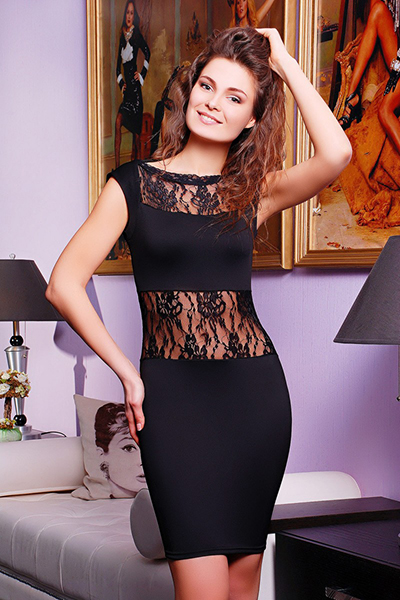







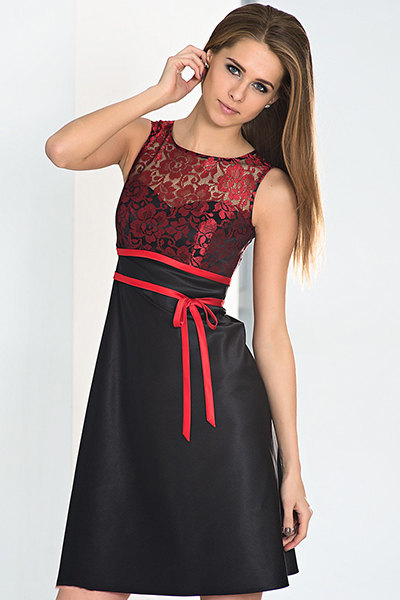

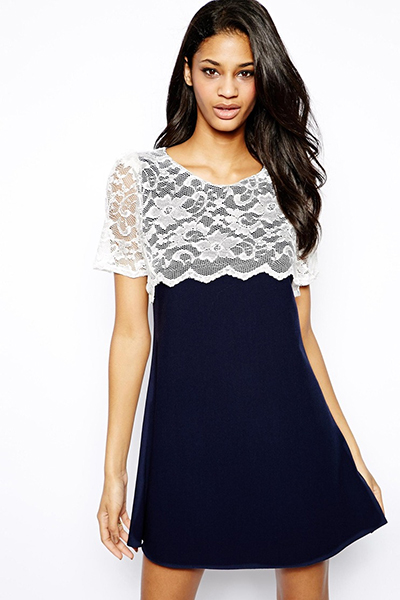






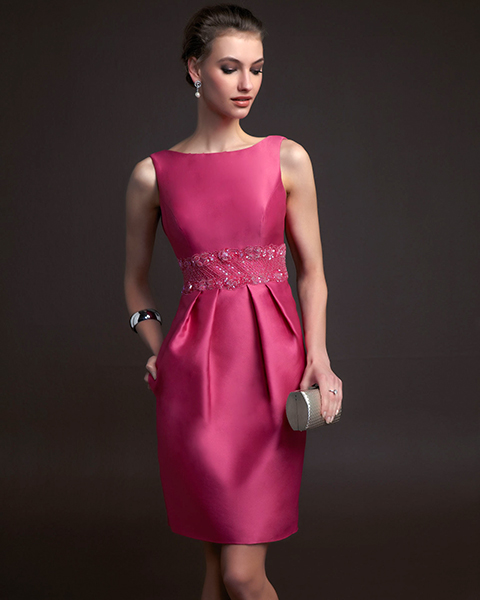



Hello, dear Fchane!
This is my first MK. I hope it will be accessible and understandable. If you like it, I will add more master classes in the future. Everyone who saw my last publication probably understood how much I love dresses) And this time, without thinking for a long time, I decided to sew another one. I found the idea with inserts on the Internet. Unfortunately, I don’t know the brand of the dress. If anyone knows, please tell me (I still wonder who I plagiarized from). Here is a picture from the Internet
For work we will need:
1) threads for knitwear
2) scissors
3) chalk
4) paper for patterns
5) black oil knitwear 1.5 - 2 m.
6) transparent bi-elastic knitwear, hereinafter referred to as “knitted mesh” 0.5 m. I don’t know the exact name of this fabric(
She looks like this
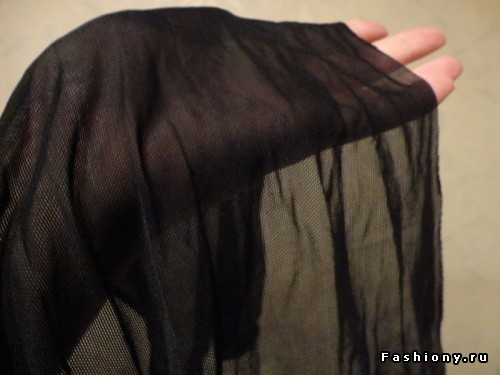
1) We build patterns, or copy suitable ones from a magazine. Front panel, back panel, sleeve.
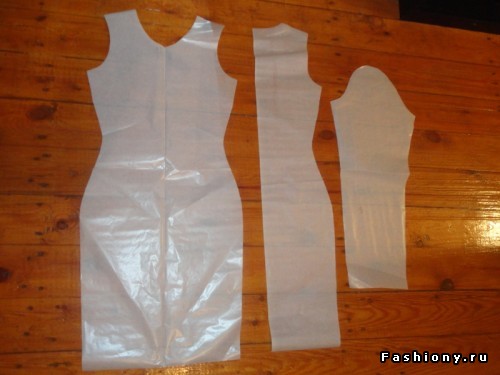
2) We also make patterns for the neck facing, 4 cm wide.
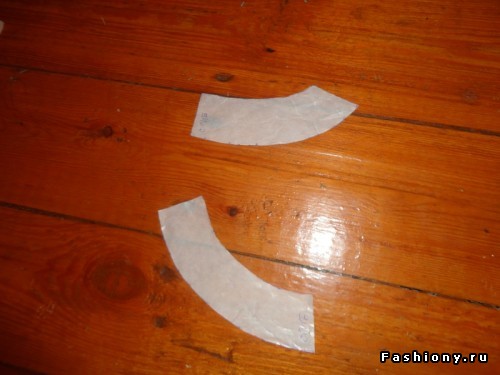
3) Now you need to draw the cutout locations on the front panel. They should be at the waist. Cutouts can be arbitrary, but care should be taken to ensure that underwear is not visible in the cutouts.
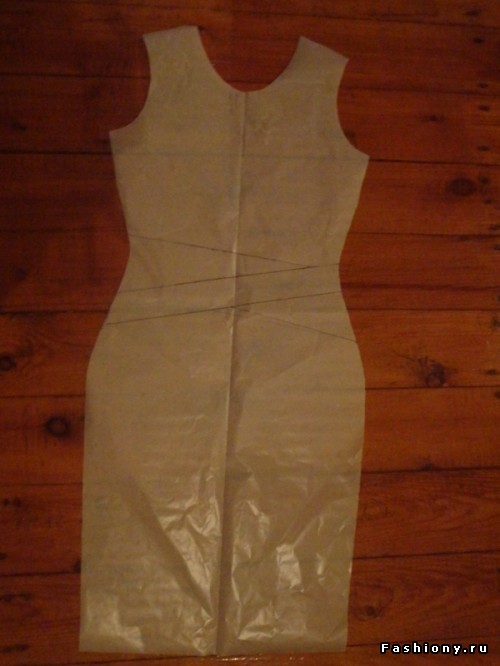
4) To make it more convenient, I shaded the side triangles; they will be cut from a knitted mesh.
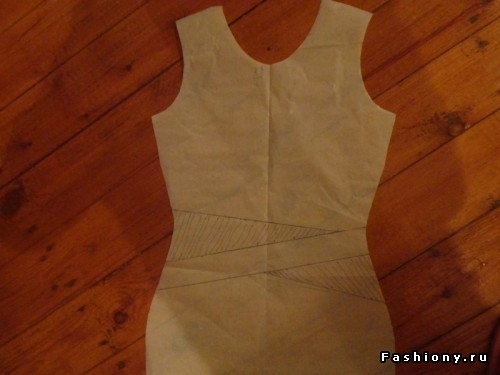
5) Cut the pattern along the drawn lines.
A.
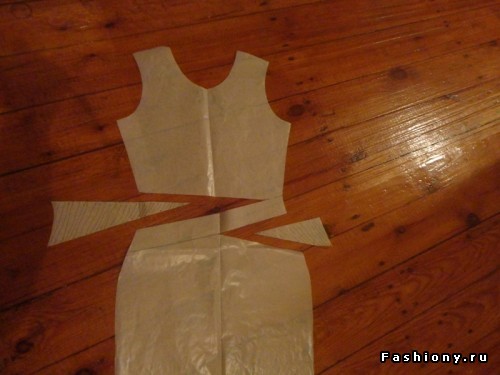
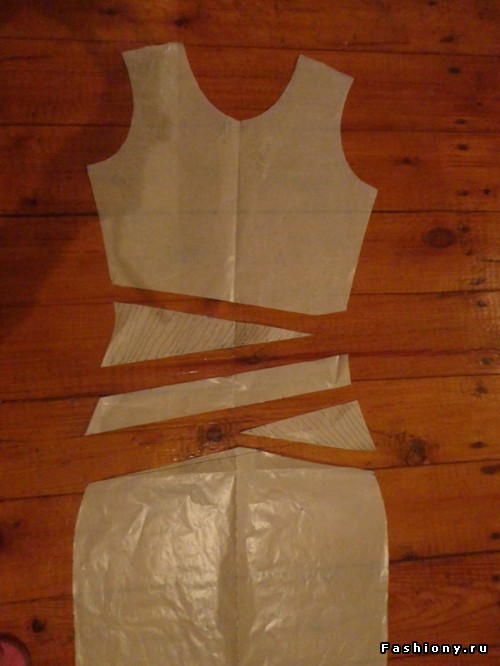
6) All details of patterns. We transfer them to fabric. We transfer the shaded parts onto a knitted mesh. Seam allowance - 1.5 cm. Hem allowance for hem and sleeves - 2 cm.
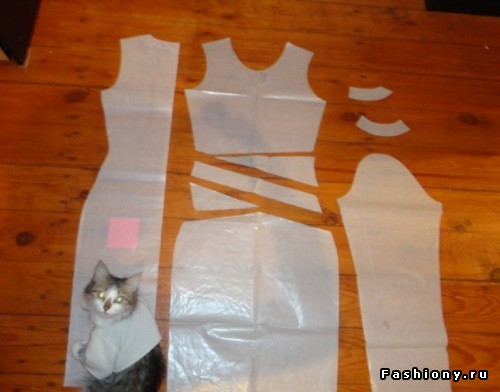
I decided not to use an overlocker, since the oily knitwear does not fray at the edges, even after machine washing (a lazy person will always find an excuse).
7) The cut front panel must be “assembled” back. For this I used tailor's pins.
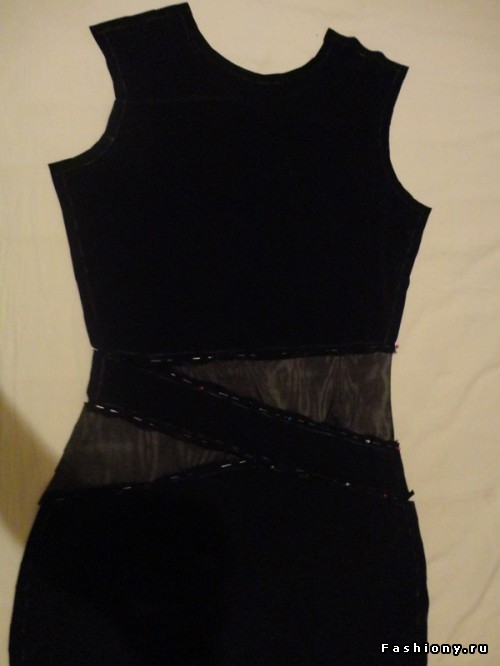
Closer photo.
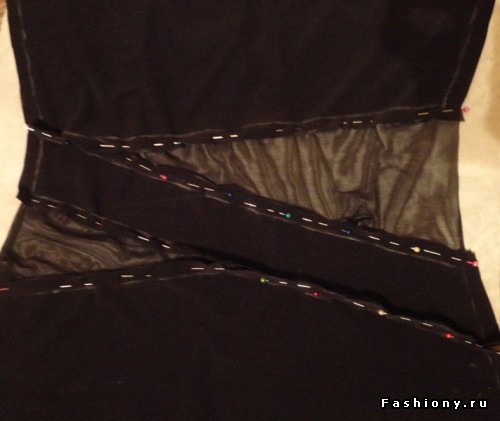
8) We grind all the parts of the front on a machine.
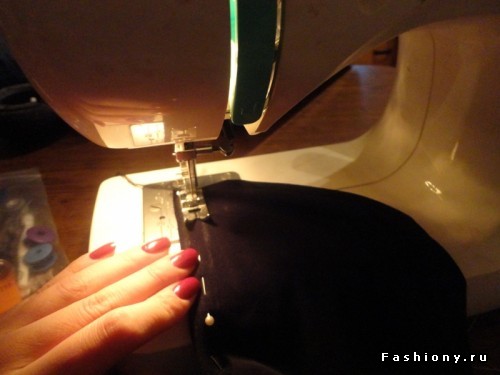
9) On the wrong side, bend the seam allowances so that they are not visible through the transparent fabric. Iron it with an iron.
![]()
10) We do the stitching (with larger stitches).




